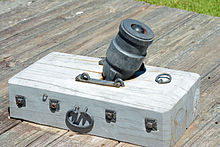Coehoorn mortar
The Coehoorn mortar (often also Coehorn , Cohorn or Kuhhorn translated into German ) was a small, portable mortar . It was developed in 1673 by the Dutchman Menno van Coehoorn and was first used at the siege of Grave (1674). This type of mortar was used until the late 19th century , when it was retired without replacement. It was used by both besiegers and defenders. The mortar was brought close to the enemy in the sap . The purpose was thus the same as that of the later trench mortars in World War I (1914–1918). In the absence of suitable weapons at the beginning of the First World War, France took the mortars, which were already technically obsolete, from the arsenals .
The mortar was a muzzle-loader with a smooth barrel made of bronze or iron . A simple wooden base plate with handles attached to the sides served as a carriage . Because of its relatively low weight, the gun barrel had no handles . The pipe elevation was usually set to a fixed 45 °. Grenades were fired , the range of which was determined by the amount of propellant charge .
The Coehoorn mortar came in different sizes. The light had a caliber of about 10 to 13 cm, or 6 to 16 pounds. The mortars weighed 25 to 40 kg and could be carried by two men. The range was up to 500 m.
In the American Civil War (1861–1865) the heavy 24-pounder was also used by both sides. It had a range of 1,100 m, weighed 136 kg and had to be carried by four men.
Web links
Individual evidence
- ↑ a b c Spencer C. Tucker : Instruments of War: Weapons and Technologies That Have Changed History :, Verlag ABC-CLIO , 2015, ISBN 9781440836558 , p. 61, Google Books .
- ^ Karl Heinrich Aster : The doctrine of the fortress wars, Volume 1 , Verlag Arnold, 1835, p. 399 [1]
- ↑ a b Tillmann Reibert: The emergence of a new type of weapon as a reaction to the conditions of trench warfare; Dissertation to obtain the doctoral degree , 2013, University of Hamburg , pp. 49–50, online .
- ^ Archives for the officers of the Royal Prussian Artillery and Engineer Corps, Volume 59 , Mittler Verlag , 1866, p. 143, Google Books .
- ↑ James Gillispie: Cape Fear Confederates: The 18th North Carolina Regiment in the Civil War , McFarland Verlag, 2012, ISBN 9780786486861 , p. 193, Google Books .
- ^ Dale Clarke: World War I Battlefield Artillery Tactics , Osprey Publishing , 2014, ISBN 9781782005926 , p. 38, Google Books .
- ↑ Brief description of weapons in the Imperial and Royal Austrian Army , Tanzer Verlag, 1844, p. 66, Google Books .
- ↑ Hartwig Neumann : Fortress architecture and fortification technology: German defense architecture from the XV. to XX. Century Verlag Bernard & Graefe, 1988, ISBN 9783763758395 , p. 301, Google Books .
- ↑ James C. Hazlett, Edwin Olmstead, M. Hume Parks: Field Artillery Weapons of the Civil War Verlag University of Illinois Press , 2004, ISBN 9780252072109 , pp. 139-140, Google Books .

